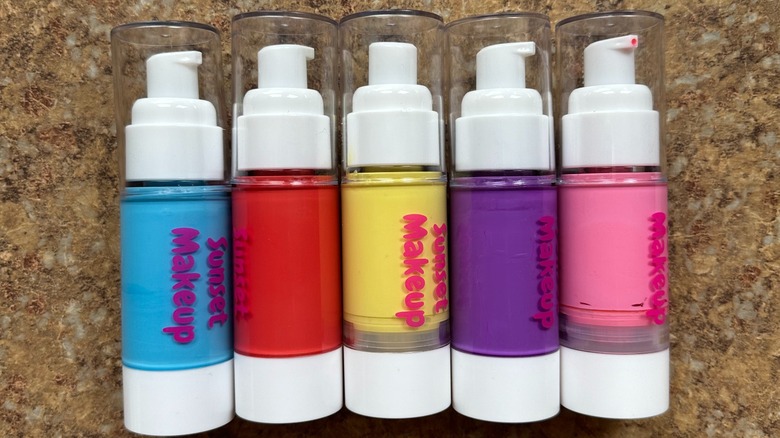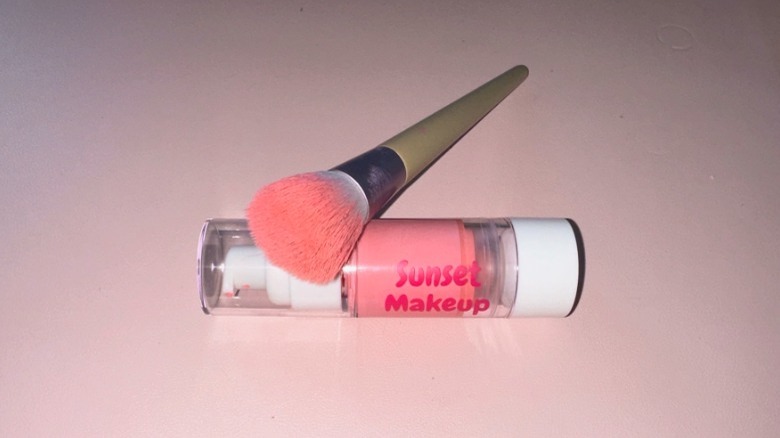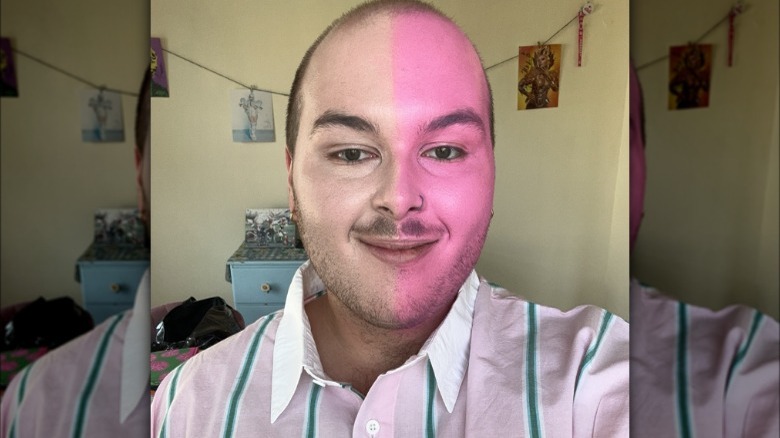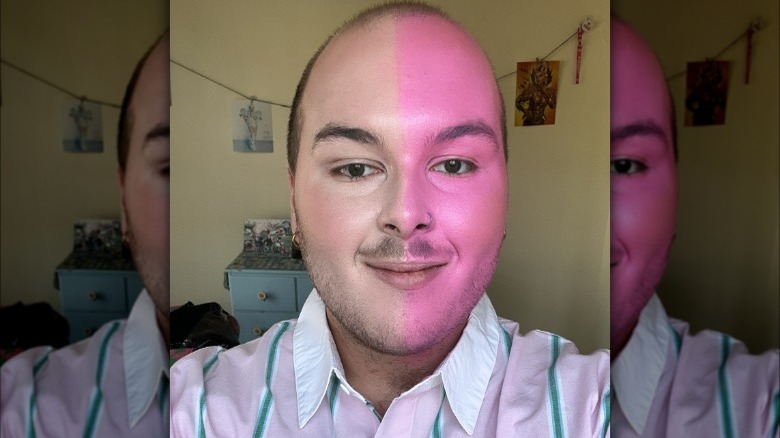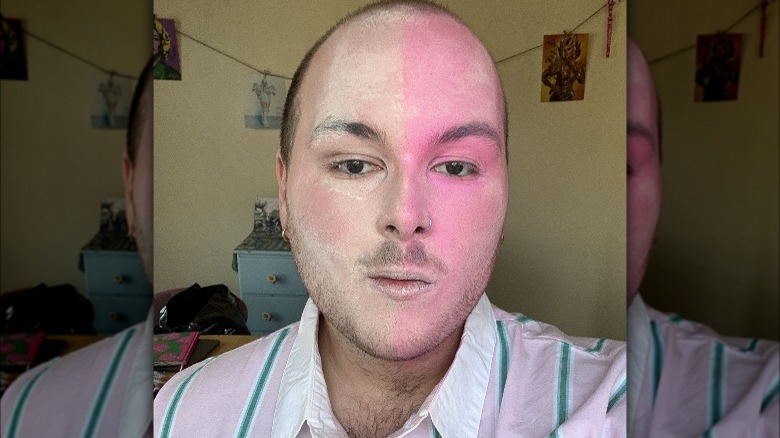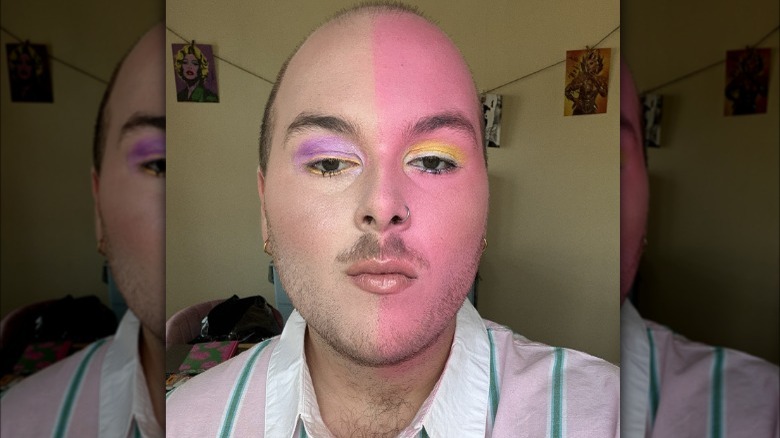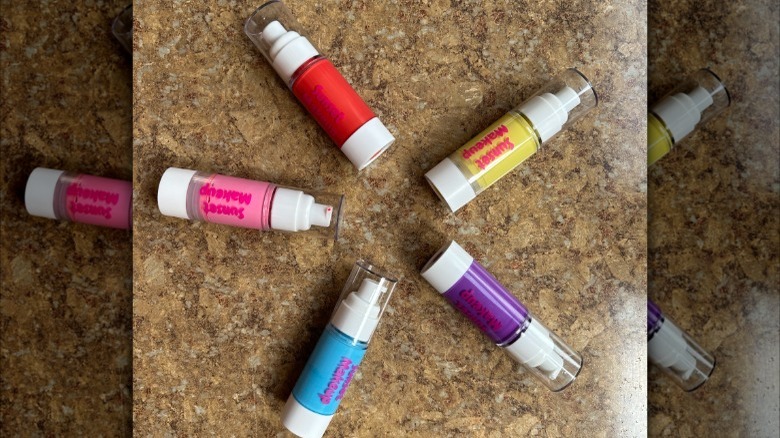Myths About Color Foundation You Shouldn't Believe
We may receive a commission on purchases made from links.
When it comes to multitasking makeup, few cosmetics come close to color foundation. Beloved by cosplayers, professional makeup artists, clowns, and goth kids alike, color foundation is the type of product that many beauty lovers simply can't live without. From special events to stage productions, color foundation can help create looks that just wouldn't be possible with run-of-the-mill foundations. On top of that, color foundation can even help you find your perfect makeup shades. But for all its merits, the vibrant product does have some serious misconceptions surrounding it.
Chances are that you've seen the viral videos of influencers slathering themselves in blue base coats just for fun, but there's so much more to color foundation than sheer shock value. Beyond cosplay and character makeup, color foundation can help you match your skin's true undertones for a more natural-looking finish or truly lit-from-within blush. Best of all, you don't need to be an expert in color theory makeup to add color foundation to your beauty arsenal. Now, let's take a look at some of the most pervasive myths about color foundation — and the reasons why you should add this wonder product to your makeup bag.
Myth: All color foundations are the same
Just like traditional foundation products, color foundations vary in consistency, pigmentation, and price. If your skin is oily, acne-prone, or sensitive, it's wise to compare reviews for different color foundations before trying one out on yourself. Some color foundations have more hydrating properties to soothe dry complexions, while others provide mattifying effects suitable for oily skin types.
If you want to dip your toes into the waters of color foundation, there are a few things to consider first. There's nothing worse than purchasing specialty makeup only to use it once and forget it, so ask yourself what your overall goal is before investing in color foundation products. If you're only planning to use color foundation for a single costume or character, then there's little need to invest in a color foundation palette, like the Make Up For Ever Flash Color Palette. The Make Up For Ever Flash Color Palette is great if you regularly cosplay or create looks for social media thanks to its many colors, but it's not necessary for beginners or occasional makeup hobbyists. If you're on the hunt for individual shades instead, you may want to check out Sunset Makeup, a beauty brand known for its highly pigmented color foundations. Last but not least, you may have success using a drugstore buy like L.A. Girl Pro.Color Foundation Mixing Pigment, though this line's shade range is limited to white, orange, yellow, and blue hues.
Myth: Color foundation is only for fantasy looks
Think color foundation is just for Halloween makeup looks? Think again. The possibilities are endless when using color foundation in your makeup routine. Case in point: You can use color foundation to fix discoloration or blemishes and customize the shade of your existing cosmetics. If you've ever used green concealer to mask the appearance of dark spots or hyperpigmentation, then you're already well-acquainted with the principles of color-correcting in makeup. Not only can color foundation help you correct imperfections like dark under-eye circles and blemishes, but it can also add warmth to cool-toned foundations or adjust your blush to the desired tint.
Similar to food coloring or paint, a few drops of color foundation can go a long way — and yes, this can lead to unsightly results. Thus, it's important to start slow if you're using it to color-correct your hyperpigmentation or color match your foundation. Instead of adding color foundation to your mixing palette directly from the pump, try using a fine-tipped makeup brush to swirl in a tiny amount of product at a time. If you have access to more than one shade of color foundation, you can use the color wheel to correct mistakes. For example, if your foundation is looking slightly too warm, you can cool it down with a bit of green or blue pigment to offset red or orange undertones.
Myth: You need to be an expert to use color foundation
Just because you associate color foundation with stage makeup looks, like Elphaba's green skin in "Wicked," doesn't mean you need to be a pro makeup artist to try it out at home. Understanding basic color mixing can certainly help you create intricate makeup looks with color foundation, but there's no better way to learn the principles of color theory than through trial and error. And once you've mastered the art of color mixing and matching, it's far easier to work with color foundation than you might think. Despite its brilliant appearance, color foundation performs very similarly to traditional foundation products.
If you're capable of the basics, like blending, contouring, and sealing your everyday makeup, you should have no problem when it comes to using color foundation. Whether you like to apply it with your fingertips, a beauty sponge, or a brush, you'll likely find that color foundation isn't all that different from liquid or cream makeup products that you've used in the past. In fact, you can even set color foundation with the same translucent powder you use for your day-to-day makeup. The biggest difference in using color foundation is, of course, getting used to its otherworldly tint.
Myth: Color foundation is just like face paint
Contrary to popular belief, color foundation and face paint aren't interchangeable products. Most professional face paints are water-activated — with some exceptions — while color foundation is often silicone or oil-based, similar to conventional foundation. Though color foundation products vary in formulation, they're often easier to work with if you've already used foundation in the past. On the other hand, face paint can require a learning curve to apply properly and won't blend well with other oil-based cosmetics like concealer or cream blush. Water-activated face paint can also be slightly trickier to apply than color foundation, particularly if you're trying to cover larger areas of the face or body.
Another important factor to consider is that water-based face paint can be quite drying, especially if worn for prolonged periods of time. Color foundation is a superior choice for many long-wear situations, like plays or costume parties, as it tends to feature emollient ingredients to keep skin feeling moisturized. Additionally, color foundation is less likely to crack, peel, or flake off of the skin than face paint, especially if you seal it with setting powder or setting spray as soon as you apply it.
You can use color foundation as eye makeup
It's tempting to use color foundation for graphic eyeliner looks, but that's one area where you should draw the line — literally. Unless the color foundation you purchase specifically states that it's safe to use on or around the eyes, it's best to exercise caution with this delicate area of the face to avoid eye irritation, styes, or infection. Just because social media stars apply everything from color foundation to glitter directly atop their eyelids, it doesn't mean that they're approved for use on the eyes. For clarification on whether your makeup is safe for your eyes, check your color foundation's packaging and official product description or reach out to the manufacturer directly. Otherwise, you can check with your optometrist or ophthalmologist if you're still unsure.
If you're still adamant about covering your eyes with a matching pigment, don't worry. There are plenty of ways to brighten up your lids without compromising the health of your eyes. Eyeshadow paints or bases are available in a rainbow of colors to suit just about any undertone of makeup. Simply apply a thin layer to the orbital area and blend it into your color foundation using clean fingers, a dense brush, or a beauty sponge. From there, you can add your favorite colored liquid or pressed eyeshadow to blend and seal the look.
Myth: Color foundation will cause breakouts
You may have heard about stage makeup's reputation for causing acne. While its heavy pigmentation may give you pause, that isn't necessarily true of color foundation. Some products may contain heavier ingredients than others, but many color foundations are formulated using non-comedogenic ingredients to prevent breakouts with prolonged wear. A good rule of thumb is to check verified product reviews and ingredient lists to determine whether a color foundation is a good fit for acne-prone skin. As with any type of makeup, however, it's all in how you use your color foundation.
In order to minimize breakouts altogether, always keep your hands, tools, and workspace clean to prevent the spread of acne-causing bacteria. Sometimes, it may not be the product itself that's behind new breakouts, but a neglected makeup brush instead. When applying liquid makeup such as color foundation, it's crucial to use a clean makeup brush so as not to muddy its color or cause acne. Lastly, no matter which color foundation you choose, don't forget to double cleanse at the end of the night. Your skin — and your pillowcases — will thank you.
